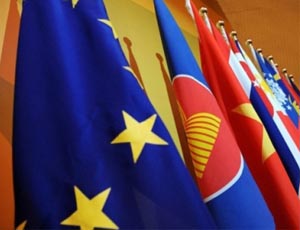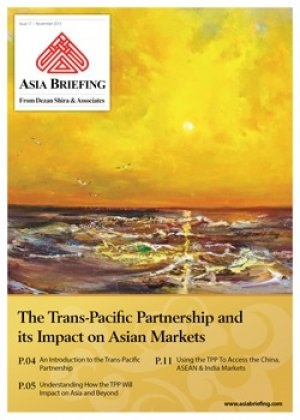Germany’s Trade with ASEAN – a Look Ahead Part One
By: Mareike Entzian
 As 2015 has come to an end, both Germany and ASEAN can reflect back on an impressive year of trade relations. In a climate of global uncertainty, both geographical regions managed to expand trade and sign several important trade agreements. With its population of roughly 622 million people, the ten ASEAN nations present a stable political environment and a growing middle class, whose purchasing power will rise over the next years. The countries present a formidable export market for German goods, as well as a stable investment climate for production and outward FDI.
As 2015 has come to an end, both Germany and ASEAN can reflect back on an impressive year of trade relations. In a climate of global uncertainty, both geographical regions managed to expand trade and sign several important trade agreements. With its population of roughly 622 million people, the ten ASEAN nations present a stable political environment and a growing middle class, whose purchasing power will rise over the next years. The countries present a formidable export market for German goods, as well as a stable investment climate for production and outward FDI.
Most recently, Germany, as part of the European Union, entered into a Free Trade Agreement with Vietnam. A declaration on the agreement was signed in early December 2015 and entry into force is expected – even by conservative estimates – as soon as 2018. ASEAN still counts as one of the most important growth markets for German industry and there remains untapped potential, especially in the green energy sector. The following will give an overview of the most important ASEAN nations and their trade relationship with Germany. For the next years, growth will undoubtedly continue and businesses will move away from the traditional low cost markets, like China, to ASEAN nations.
This first installment of a two part article series will examine Germany’s trade with the dynamic ASEAN region.
A Brief Overview of ASEAN
The Association of Southeast Asian Nations is composed of ten countries, namely Brunei Darussalam, Indonesia, Cambodia, Laos, Malaysia, Myanmar, the Philippines, Singapore, Thailand and Vietnam. The association was formed in 1967 with the objective to promote economic growth through close collaboration and mutual cooperation of the nations. This article will consider the most important economic players, in relation to Germany – Indonesia, Malaysia, Singapore, Philippines, Thailand and Vietnam. The attractiveness of ASEAN as an economic community lies in its economically diverse member nations, who recently formed the Asian Economic Community, which will remove trade barriers between all members and thus create a domestic market between them. The total outward FDI inflow from European nations in 2014 amounted to US$136,2 billion, an impressive statistic.
 RELATED: Corporate Establishment Services from Dezan Shira & Associates
RELATED: Corporate Establishment Services from Dezan Shira & Associates
Free Trade Agreements and Opportunities for Growth
Germany benefits from any Free Trade Agreements negotiated and signed by the European Union. Negotiations to extend FTAs with ASEAN nations are of great economic importance to Germany, who sees ASEAN’s economic potential and dynamic business landscape as a largely untapped market. Currently, Germany lags behind bigger players like the United States and Japan, who have had a strong presence for a while and benefit from their own FTAs. German investment into the region isn’t in proportion to the opportunities present, since the ASEAN region contributes around three percent of global GDP each year. While MNCs already entered several domestic markets, new opportunities open up especially for SMEs, who have yet to tap much of the potential present. ASEAN is seen as a worthwhile alternative to the BRICS countries, with its modest predicted growth of five percent across the region in 2015-2019. Being able to take advantage of new Free Trade Agreements will surely open the market for higher level of German FDI and production inflow.
Indonesia
In a world investment report, Indonesia was consistently ranked as a top destination for foreign FDI inflow and investment rose by almost 20 percent to US $23 billion. Despite a small economic slowdown in 2014 and a generally challenging global economic climate, GDP growth is projected to reach 5.3 percent in 2015 and rise to 5.9 percent in 2016. Indonesia’s geographical proximity to Singapore makes it an excellent location to tap into ASEAN, since flights between Jakarta and Singapore are cheap, frequent, and short. German companies may want to consider establishing an office in Singapore, which gives easy access to Indonesia and other ASEAN economies.
Both political and economic relations have been traditionally strong between Indonesia and Germany, and interest in each other has grown deeper over the past years. At present, there are about 300 German companies doing business in Indonesia and besides some important MNCs, there are numerous SMEs, who cover a wide spectrum of German investment, and many of whom have own production facilities in Indonesia.
 RELATED: The Guide to Corporate Establishment in Indonesia
RELATED: The Guide to Corporate Establishment in Indonesia
Germany’s most important exports to Indonesia are machinery, chemical goods, metal and other automobile and vehicle equipment. Indonesia’s main exports to Germany are clothing, food products (plant based oils) and animal feed, agricultural products, electronics, shoes and ore. The total trade in goods with Germany slightly retracted in 2015. While total Indonesian exports marginally expanded by 0.4 percent, total German exports sank by 5.5 percent down to a value of US $3.27 billion.
Overall, Indonesia presents an excellent window of opportunity for German companies, since 43 percent of its 250 million strong population is under the age of 25 and well equipped to become a strong workforce, granted the right occupational skills are taught.
Vietnam
After engaging in talks for 2.5 years, the European Union and Government of Vietnam agreed to the text of the most comprehensive FTA ever to be concluded with a developing country, in early December 2015. The agreement presents not only opportunities for investors and businesses alike, on a political level it also establishes a new era in trade relations, which will bind the two partners closer together.
The EU-Vietnam FTA is especially attractive for Germany, since it continuously defends its position as Vietnam’s most important European trade partner. In 2014, total trade volume reached US $7.8 billion and imports rose by 5.3 percent to US $5.18 billion. German exports reached US $2.62 billion, but retracted by 6.5 percent.
The most important Vietnamese exports are shoes, textiles, agricultural products (coffee and pepper), seafood and even electronics and furniture items. Vietnam mainly imports machinery, automobile and chemical goods from Germany, since its goal is to reach the status of an industrialized country by 2020. A rise in demand of machinery “Made in Germany” is in direct correlation with the government’s goal.
|
Asia Briefing Ltd. is a subsidiary of Dezan Shira & Associates. Dezan Shira is a specialist foreign direct investment practice, providing corporate establishment, business advisory, tax advisory and compliance, accounting, payroll, due diligence and financial review services to multinationals investing in China, Hong Kong, India, Vietnam, Singapore and the rest of ASEAN. For further information, please email asean@dezshira.com or visit www.dezshira.com. Stay up to date with the latest business and investment trends in Asia by subscribing to our complimentary update service featuring news, commentary and regulatory insight. |
The 2015 Asia Tax Comparator
In this issue, we compare and contrast the most relevant tax laws applicable for businesses with a presence in Asia. We analyze the different tax rates of 13 jurisdictions in the region, including India, China, Hong Kong, and the 10 member states of ASEAN. We also take a look at some of the most important compliance issues that businesses should be aware of, and conclude by discussing some of the most important tax and finance concerns companies will face when entering Asia.
 The Trans-Pacific Partnership and its Impact on Asian Markets
The Trans-Pacific Partnership and its Impact on Asian Markets
The United States backed Trans-Pacific Partnership Agreement (TPP) includes six Asian economies – Australia, Brunei, Japan, Malaysia, Singapore and Vietnam, while Indonesia has expressed a keen willingness to join. However, the agreement’s potential impact will affect many others, not least of all China. In this issue of Asia Briefing magazine, we examine where the TPP agreement stands right now, look at the potential impact of the participating nations, as well as examine how it will affect Asian economies that have not been included.
 An Introduction to Tax Treaties Throughout Asia
An Introduction to Tax Treaties Throughout Asia
In this issue of Asia Briefing Magazine, we take a look at the various types of trade and tax treaties that exist between Asian nations. These include bilateral investment treaties, double tax treaties and free trade agreements – all of which directly affect businesses operating in Asia.








